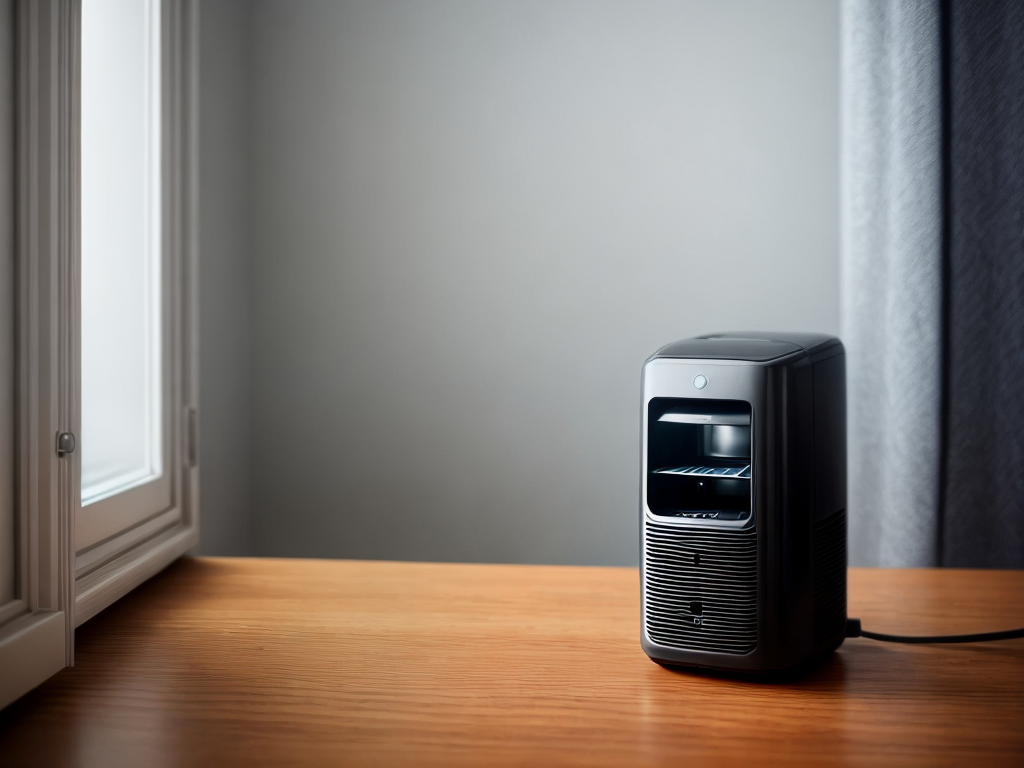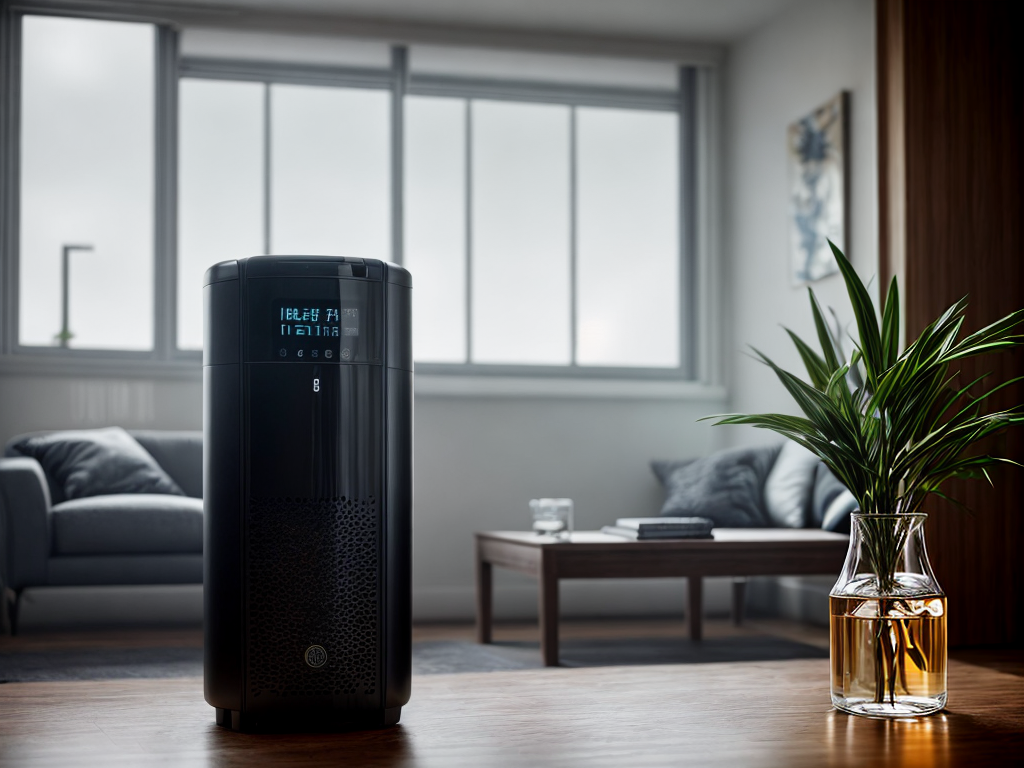
As I sit here in my cozy study, I can’t help but notice a peculiar sensation in the air. It feels heavy and damp, almost as if the room is wrapped in a wet blanket. It’s a classic case of high humidity, and it’s not just an inconvenience – it can actually have a detrimental effect on the air quality in our homes. But fear not, for there is a solution that can whisk away the excess moisture and leave you with clean, fresh air to breathe. So, what’s the secret to improving air quality? Well, it all starts with the right dehumidifier. But before we delve into the details, let me paint a picture for you…
Benefits of Using a Dehumidifier
Using a dehumidifier can greatly improve air quality in your home or office. By controlling the humidity levels, you can create a healthier environment for yourself and your family. Excess moisture in the air can lead to the growth of mold, mildew, and dust mites, which can trigger respiratory issues and allergies. However, with a dehumidifier, you can effectively reduce these allergens and create a more comfortable living space.
Humidity control is crucial for maintaining respiratory health. High humidity levels can make it difficult to breathe, especially for individuals with asthma or other respiratory conditions. By using a dehumidifier, you can reduce the moisture in the air, making it easier to breathe and reducing the risk of respiratory problems. Additionally, dehumidifiers can help alleviate symptoms like coughing, wheezing, and congestion.
Another benefit of using a dehumidifier is the prevention of mold growth. Mold thrives in damp environments, and high humidity levels provide the perfect conditions for its growth. By reducing the moisture in the air, a dehumidifier can inhibit the growth of mold, protecting your home and your health. Mold can cause a variety of health issues, including allergies, respiratory infections, and even more severe conditions in individuals with weakened immune systems.
Factors to Consider When Selecting a Dehumidifier
When selecting a dehumidifier, there are a few key factors to consider. The size and capacity of the dehumidifier is important, as it needs to be able to effectively remove moisture from your space. Additionally, energy efficiency should be taken into account to ensure that the dehumidifier operates efficiently and doesn’t consume excessive energy.
Size and Capacity
To select the right dehumidifier for your needs, consider the size and capacity that will effectively improve air quality in your space. When it comes to humidity control and moisture removal, the size and capacity of the dehumidifier are crucial factors to consider. A dehumidifier that is too small may not be able to effectively remove moisture from the air, while one that is too large may consume unnecessary energy. To determine the appropriate size and capacity, calculate the square footage of the area you want to dehumidify and consider the level of humidity in the space. A general rule of thumb is that a dehumidifier with a capacity of 30 pints per day is suitable for spaces up to 1,500 square feet, while larger spaces may require a higher capacity. By selecting the right size and capacity, you can ensure optimal air quality and efficient moisture removal in your space.
Energy Efficiency
Considering energy efficiency is another important factor when selecting a dehumidifier to improve air quality in your space. Not only does an energy-efficient dehumidifier help you save on your electricity bills, but it also reduces your environmental impact. Here are three reasons why energy efficiency matters when choosing a dehumidifier:
-
Energy savings: An energy-efficient dehumidifier consumes less electricity, resulting in lower energy bills. This allows you to control your expenses without compromising on air quality.
-
Environmental impact: Energy-efficient dehumidifiers use less power, which reduces carbon emissions and helps protect the environment. By choosing an energy-efficient option, you are contributing to a greener future.
-
Control: Opting for an energy-efficient dehumidifier puts you in control of your energy usage. You can actively manage and regulate your energy consumption without sacrificing the quality of air in your space.
Understanding the Impact of Humidity on Air Quality
Humidity significantly affects air quality, making it imperative to understand its impact. When it comes to allergies, humidity plays a crucial role. High humidity levels can promote the growth of mold and dust mites, both of which are common triggers for allergies. These allergens thrive in damp environments, leading to increased symptoms such as sneezing, coughing, and itchy eyes. By controlling humidity levels, we can minimize the presence of these allergens and create a healthier indoor environment.
Moreover, the relation between humidity and respiratory health is equally important. High humidity can make it difficult for our bodies to cool down through sweat evaporation, leading to discomfort and potential health issues. On the other hand, low humidity can dry out our respiratory system, making it more susceptible to infections and irritants. Maintaining an optimal humidity level can help prevent respiratory problems and ensure our lungs function at their best.
To gain control over air quality, it is essential to understand the impact of humidity. By investing in a dehumidifier, we can regulate humidity levels and create a comfortable and healthy environment. This will not only alleviate allergies but also improve respiratory health, allowing us to breathe easier and live better.
How a Dehumidifier Can Prevent Mold and Mildew
Understanding the impact of humidity on air quality is crucial, and one effective way to prevent the growth of mold and mildew is by using a dehumidifier. High levels of humidity create the perfect environment for mold and mildew to thrive, which can lead to a host of problems, including respiratory issues and increased allergens in the air. By utilizing a dehumidifier, you can take control of your indoor environment and enjoy the following benefits:
-
Preventing respiratory issues: Mold and mildew release spores into the air that can irritate the respiratory system and trigger allergies or asthma. A dehumidifier helps maintain a healthy humidity level, reducing the chances of respiratory problems caused by mold and mildew.
-
Reducing allergens: Dust mites, another common allergen, also thrive in humid environments. By removing excess moisture from the air, a dehumidifier creates an inhospitable environment for dust mites, helping to reduce allergens and alleviate allergy symptoms.
-
Taking control: With a dehumidifier, you have the power to maintain an optimal humidity level in your home. You no longer have to worry about the negative effects of excessive moisture, such as mold growth and the associated health risks. A dehumidifier puts you in control of your indoor air quality, ensuring a healthier and more comfortable living space for you and your family.
Tips for Maintaining and Operating Your Dehumidifier
Maintaining and operating a dehumidifier properly is essential for maximizing its effectiveness. Regular cleaning techniques such as wiping down the exterior and emptying the water tank are crucial to prevent the buildup of dirt and bacteria. Additionally, regularly checking and replacing the filters will ensure that the dehumidifier continues to remove allergens and pollutants from the air. Lastly, it is important to set the dehumidifier to optimal humidity levels to maintain a healthy and comfortable environment.
Proper Cleaning Techniques
Regular cleaning is essential for ensuring optimal performance and longevity of your dehumidifier. Here are three effective cleaning techniques to help you maintain your dehumidifier and keep moisture under control:
-
Clean the air filter: Remove the filter according to the manufacturer’s instructions and gently wash it with warm water and mild detergent. Let it air dry completely before reinserting it into the unit. A clean filter allows for better air circulation and prevents dust and debris from clogging the system.
-
Wipe down the exterior: Use a damp cloth to wipe down the exterior of your dehumidifier regularly. This helps remove any dirt or dust that may have accumulated and keeps the unit looking clean and well-maintained.
-
Empty the water tank: Depending on the model, you may need to manually empty the water tank. Regularly check the tank and empty it when it is full to prevent overflow and ensure efficient moisture removal.
Regular Filter Maintenance
After ensuring proper cleaning techniques, maintaining and operating your dehumidifier’s filter is crucial for optimal performance and air quality. Regular filter replacement and maintenance are essential to keep your dehumidifier running efficiently and effectively. By regularly replacing the filter, you can ensure that it is not clogged with dirt, dust, and other pollutants, allowing it to continue filtering the air effectively. Regular maintenance also helps to prevent the buildup of mold, mildew, and bacteria within the filter, which can negatively impact air quality. To help you keep track of when to replace your filter, here is a simple maintenance schedule:
| Maintenance Task | Frequency |
|---|---|
| Check filter for dirt and debris | Monthly |
| Replace filter | Every 3-6 months |
| Clean filter housing | Annually |
| Inspect for damage or wear | Every 6 months |
| Clean or replace pre-filter | Every 1-2 months |
Following this maintenance schedule will ensure that your dehumidifier continues to operate at its best and improves air quality in your home.
Optimal Humidity Levels
To maintain optimal humidity levels and effectively operate your dehumidifier, it is important to follow a few key tips. Here are three crucial tips to help you maintain the optimal humidity levels in your home:
-
Set the optimal temperature: Keep your home at a consistent temperature of around 68-72 degrees Fahrenheit. This temperature range helps prevent excessive moisture buildup and reduces the risk of mold and mildew growth.
-
Monitor and adjust humidity levels: Aim for a humidity level between 30% and 50% to maintain optimal air quality. High humidity can lead to condensation and dampness, which can promote the growth of bacteria and allergens. On the other hand, low humidity can cause dry skin and respiratory discomfort.
-
Regularly clean and maintain your dehumidifier: Clean the water tank and filters regularly to ensure efficient operation. This will help prevent the accumulation of dust and bacteria, promoting healthier air quality.
Choosing the Right Size Dehumidifier for Your Space
When selecting a dehumidifier for your space, it is important to consider the size of the area you want to improve air quality in. Choosing the right size dehumidifier is crucial for effective humidity control and optimal performance. If the dehumidifier is too small for the space, it may not be able to extract enough moisture from the air. On the other hand, if the dehumidifier is too large, it may cycle on and off frequently, leading to inefficient operation and unnecessary energy consumption.
To determine the right size dehumidifier for your space, you need to calculate the square footage of the area. Most manufacturers provide guidelines for selecting the appropriate capacity based on the square footage. You can also consider the relative humidity levels in your area. If you live in a humid climate, you may need a larger capacity dehumidifier to effectively control moisture.
Once you have chosen the right size dehumidifier, it is important to follow proper dehumidifier maintenance to ensure its longevity and performance. Regularly clean and replace the filters, empty the water tank, and inspect the coils for any debris or buildup. Additionally, check the manufacturer’s instructions for any specific maintenance requirements.
Other Ways to Improve Air Quality in Your Home
I have found that implementing additional methods can significantly enhance the air quality in your home. In addition to using a dehumidifier, there are a few other ways you can improve the air quality in your living space:
-
Indoor Plants: Bringing nature indoors not only adds beauty to your home but also helps purify the air. Indoor plants such as aloe vera, spider plant, and peace lily can effectively filter out toxins and release oxygen, improving the overall air quality. These plants are easy to care for and can thrive in various indoor environments.
-
Air Purifiers: Investing in a quality air purifier can make a noticeable difference in the air you breathe. Air purifiers work by trapping and removing airborne pollutants, such as dust, pet dander, and allergens. Look for purifiers with HEPA filters, as they are highly efficient in capturing small particles.
-
Proper Ventilation: Proper ventilation is crucial for maintaining good air quality. Make sure your home has adequate ventilation systems in place, such as exhaust fans in kitchens and bathrooms. Opening windows regularly to let in fresh air can also help remove indoor pollutants and improve air circulation.








